Android 4.0 Launcher2源碼分析——主布局文件(轉)
本文來自http://blog.csdn.net/chenshaoyang0011
Android系統的一大特色是它擁有的桌面通知系統,不同於IOS的桌面管理,Android有一個桌面系統用於管理和展示APP以及桌面Widget等。
Android提供一個默認的桌面應用,當然我們也可以使用第三方的桌面應用。Android的Launcher的源碼在 \packages\apps\Launcher2。
Launcher2的主布局文件包括res\layout-land\launcher.xml
, res\layout-port\launcher.xml , res\layout-sw600dp\launcher.xml ,分別適配橫屏,豎屏和7寸平板。內容大同小異,這裏就以res\layout-port\launcher.xml的為例。
首先讓我們看看launcher.xml中的結構:
- <com.android.launcher2.DragLayer
- xmlns:android="http://schemas.android.com/apk/res/android"
- xmlns:launcher="http://schemas.android.com/apk/res/com.android.launcher"
- android:id="@+id/drag_layer"
- ...
- >
- <!-- Keep these behind the workspace so that they are not visible when
- we go into AllApps -->
- <include
- android:id="@+id/dock_divider"
- layout="@layout/workspace_divider"
- ...
- />
- <!-- 分頁指示器 -->
- <include
- android:id="@+id/paged_view_indicator"
- layout="@layout/scroll_indicator"
- ...
- />
- <!-- The workspace contains 5 screens of cells -->
- <com.android.launcher2.Workspace
- android:id="@+id/workspace"
- ...
- >
- <!-- 五個分屏,默認顯示cell3 -->
- <include android:id="@+id/cell1" layout="@layout/workspace_screen" />
- <include android:id="@+id/cell2" layout="@layout/workspace_screen" />
- <include android:id="@+id/cell3" layout="@layout/workspace_screen" />
- <include android:id="@+id/cell4" layout="@layout/workspace_screen" />
- <include android:id="@+id/cell5" layout="@layout/workspace_screen" />
- </com.android.launcher2.Workspace>
- <!-- 搜索框/刪除框 -->
- <include
- android:id="@+id/qsb_bar"
- layout="@layout/qsb_bar" />
- <!-- 顯示具體全部應用的界面,包括APPS、WIGHETS的tab標簽,以及顯示ALL APP的頁面和現實APP WIGHETS的頁面 -->
- <include layout="@layout/apps_customize_pane"
- android:id="@+id/apps_customize_pane"
- ..
- />
- <!-- WorkSpace最下面的五個快捷位置 -->
- <include layout="@layout/hotseat"
- android:id="@+id/hotseat"
- ..
- />
- <!-- 剛啟動的時候顯示的指導頁 -->
- <include layout="@layout/workspace_cling"
- android:id="@+id/workspace_cling"
- ...
- />
- <!-- 是第一次進入全部應用之後顯示的指導頁 -->
- <include layout="@layout/folder_cling"
- android:id="@+id/folder_cling"
- ...
- />
- </com.android.launcher2.DragLayer>
接著我們來一一認識每一個View控件。
1、最外層的DragLayer,是一個繼承自FramLayout的View控件,顯示的就是整個桌面根容器。桌面的所有控件都是位於DragLayer中。
2、id/dock_divider,使用了布局workspace_divider,其實就是一個ImageView。是Workspace與Hotseat之間的分割線。

3、id/paged_view_indicator,使用了布局scroll_indicator,顯示效果是在id/dock_divider上顯示一條淡藍色的橫線,來指示當分屏所處的位置
4、id/workspace ,工作空間擁有五個workspace_screen,即有五個分屏,每個分屏都可以放置shortcut和AppWidget,效果如下:
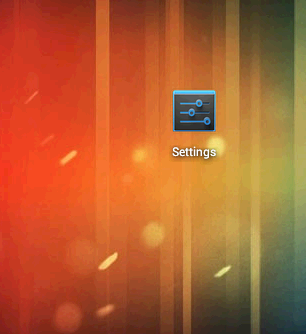
5、id/cell1..cell5 ,分別代表五個分屏
6、id/qsb_bar 搜索框/刪除框,根據需要進行切換


7、id/apps_customize_pane,效果如下
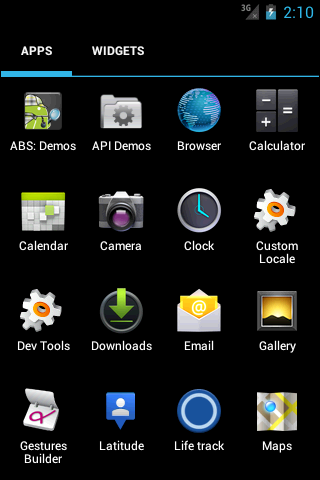
8、id/hotseat 即主屏幕下方的五個快捷位置

9、id/workspace_cling當第一次運行Launcher2時,會顯示的用於指導的動畫,以後不再顯示
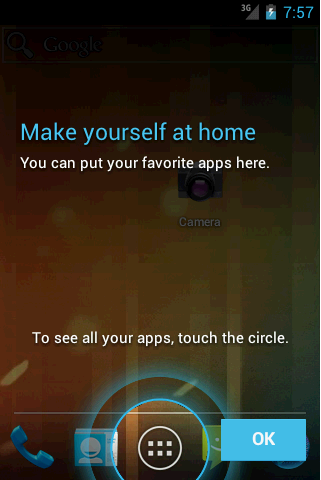
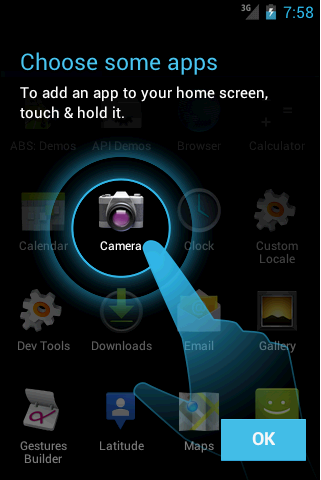
10、id/folder_cling,第一次使用Folder時,展示給用戶的指導畫面。
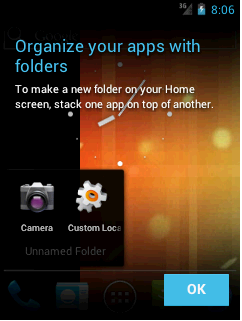
這樣,我們已經可以使每個UI界面及組件都對號入座,這會使接下來分析的時候更加清晰。
Android 4.0 Launcher2源碼分析——主布局文件(轉)
